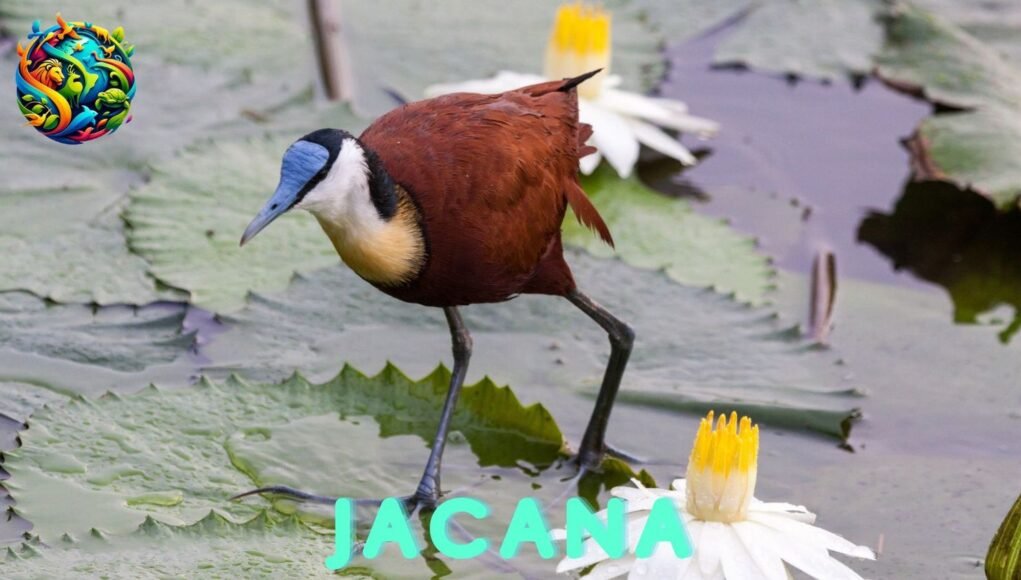Introduction
The jacana, a captivating group of tropical water birds, conjures images of vibrant colors and eerie calls amidst the lush wetlands of Central and South America, Africa, and parts of Asia. Known for their unique lifestyle and ability to walk on lily pads, these birds often evoke both wonder and admiration. As fellow inhabitants of this Earth, humans find a shared connection with the jacana’s intriguing struggle for survival in fragile ecosystems, reminding us of our responsibility to protect such extraordinary wildlife.
Incredible Facts about jacana
- Superb Swimmers: Jacanas are excellent swimmers, able to navigate their watery environments with remarkable agility.
- Unique Feet: Their large, elongated toes allow jacanas to distribute their weight across floating vegetation, enabling them to walk gracefully on lilies and other aquatic plants.
- Parental Care: Male jacanas play a significant role in raising their young, often defending their nests fiercely from predators.
- Diverse Habitats: These wading birds thrive in a variety of jacana habitat and behavior, favoring wetlands, marshes, and flooded fields.
Physical Traits & Adaptations
One of the most striking characteristics of the jacana is its extraordinary foot structure. With long toes that can span up to 30 centimeters, these adaptations allow the bird to effectively distribute its weight across soft, floating vegetation. This unique feature gives jacanas their nickname, “Jesus birds,” as they seem to walk on water with ease, an especially vivid sight against the backdrop of lush lily pads. Additionally, their vibrant plumage often features shades of green, blue, and yellow. This not only serves a vital role in mating displays but also aids in camouflage against the colorful and complex habitats in which they reside.
Their social behavior highlights another fascinating aspect of their adaptation: the communal nesting systems. In contrast to many bird species, where males pursue females, jacanas exhibit a fascinating role reversal. The less colorful males are responsible for incubating the eggs and caring for the hatchlings while the more vibrant females pursue multiple mates. This not only maximizes genetic diversity but showcases the complexity of avian reproductive strategies in the wild.
In the dance of life across the wetlands, jacanas remind us of the balance between vulnerability and grace, a reflection of nature’s intricate tapestry.
Habitat and Ecosystem
Natural Range
Jacanas, a captivating group of wading birds belonging to the family Jacanidae, are primarily found in the lush wetlands and shallow waters of tropical and subtropical regions around the world. Their natural range extends from the marshes of Central America down through the vast wetlands of South America, as well as in parts of Africa and Asia. Notably, the Northern Jacana can often be seen elegantly walking among the vibrant greenery of the Pantanal ecosystem, one of the world’s largest tropical wetlands located in Brazil. This rich biome, with its intricate tapestry of flooded grasslands, lagoons, and a plethora of aquatic plants, serves as a stunning backdrop for these remarkable birds.
Climate and Adaptation
Jacanas thrive in climates characterized by warm temperatures and seasonal rainfall, which create suitable breeding habitats filled with rich vegetation. Their physiological adaptations allow them to navigate these environments with grace; they boast long toes and elongated toes which enable them to walk on floating vegetation — a trait that offers them a unique ecological advantage. Within their primary habitats, jacanas can often be seen deftly balancing on lily pads and other water plants, showcasing a remarkable coexistence with their environment. During the rainy season, the water levels rise, transforming the landscape and allowing the jacanas to forage extensively among the lush plants and insects that thrive in these dynamic wetland systems.
Diet and Feeding Behavior
As omnivorous foragers, jacanas have a diverse diet that primarily consists of seeds, fruits, and small invertebrates, which they diligently search for among the blossoms of water lilies. They are equipped with specialized feeding behaviors that enhance their survival in the wetland ecosystems. By using their long, spindly toes to probe the soft substrate of the water, jacanas can access hidden morsels that many other species cannot reach. This adaptation highlights their niche within the ecosystem, where they contribute to the health and balance of their habitat by helping control insect populations and dispersing various plant species through their feeding activities. The symbiotic relationship between jacanas and their environment illustrates the delicate interdependencies present within these rich biomes.
Predators and Threats
In the Wild
In the wild, jacanas face various natural predators, including birds of prey, snakes, and large fish that inhabit their watery environments. Their low-flying, skimming flight pattern makes them relatively swift at evasion, while their careful walking on floating plants provides natural camouflage against larger threats. Nests, carefully constructed in dense vegetation just above water level, provide additional safety, yet they remain vulnerable to opportunistic predators who have honed in on their breeding sites.
Human Impact
Unfortunately, human activities pose significant challenges to jacana populations. Wetland drainage for agricultural development, pollution, and urban expansion disrupt their habitats and degrade water quality, thereby threatening their food sources and nesting sites. Habitat loss remains a primary concern, particularly in inundated regions like the Pantanal, where the delicate balance of the ecosystem is undermined by human intervention. Furthermore, climate change exacerbates these threats by altering precipitation patterns and increasing the frequency of extreme weather events, impacting the availability of suitable wetland habitats.
Conservation Efforts
To combat these threats, conservation efforts are being initiated across regions where jacanas thrive. Organizations are working to restore and protect wetland habitats, implementing measures to restore natural water flow and limit pollution. Initiatives that engage local communities in the stewardship of these ecosystems are paramount, as they can foster greater awareness and encourage sustainable practices. Ongoing research is also crucial, monitoring jacana populations and their health to understand the impacts of environmental change and human interaction. By prioritizing conservation efforts for jacanas and their habitats, we can help to ensure that these remarkable birds continue to thrive alongside the rich biodiversity of the wetlands they call home.
Species and Classifications
The jacana, a strikingly beautiful bird known for its long legs and unique lifestyle, belongs to the family Jacanidae. Within this family, there are several species, each with its own charm and adaptations to their wetland habitats. The most widely recognized species include the Jacana jacana, or the Northern Jacana, Metopidius indicus, known as the Pheasant-tailed Jacana, and Ablepharus somervillae, commonly referred to as the Lesser Jacana.
The Northern Jacana, predominately found across Central America and parts of South America, exhibits a striking plumage of chestnut and golden-yellow, complemented by large, paddle-like feet, which allow it to navigate the floating vegetation effortlessly. In contrast, the Pheasant-tailed Jacana, native to parts of Asia, boasts an extravagant tail that resembles that of a peacock, particularly in males during the breeding season. This tail helps them in courtship displays but also complicates their ability to maneuver themselves swiftly amongst reeds. Lastly, the Lesser Jacana, smaller than its relatives, prefers shallow marshes and is often more elusive, making it a treat for birdwatchers to catch a glimpse of.
Mating, Family, and Communication
Jacanas display a fascinating range of social behaviors and breeding practices that defy conventional norms in the avian world. In what can be described as a matriarchal society, female jacanas are larger and more vibrant than males, often taking the lead in courtship and territory establishment. During mating season, a female will claim a territory and attract multiple males, who will then compete for her affection. It’s not uncommon to find a single female partnered with several males, who become responsible for incubating the eggs and caring for the young.
One can witness this intriguing behavior in action at a marshy wetland in Nicaragua. As I watched a vivacious female Northern Jacana strut across the lily pads, she called out, her voice echoing in the still air—a melodious series of whistling notes. Soon, three suitors arrived, each trying to show off his agility, delicately stepping over the water with his long toes, chasing each other around the pads. It’s a veritable dance of love, showcasing not just their physical prowess, but also their unique communication styles. The males also emit a series of soft calls, which seem to resonate with their nurturing instincts, a kind of motivation to ensure that their brood thrives.
Humans and jacana
Jacanas have made their mark beyond the realms of natural beauty, weaving themselves into cultural narratives and artistic expressions. In many indigenous cultures of South America, jacanas symbolize resilience and teamwork. Their distinctive mating system and caring behaviors often serve as metaphors for family ties and cooperation in community life. For instance, the Northern Jacana is celebrated in local folklore as a bird that teaches the importance of nurturing future generations. Artists frequently use the jacana as inspiration, capturing its elegance in paintings, textile designs, and even in public sculptures, emphasizing its connection to water and nature.
Additionally, jacanas have appeared in various media, particularly in documentaries and nature films focused on wetlands and ecological diversity, highlighting their unique adaptations and behaviors. The vivid imagery of these birds gracefully walking over water always seems to resonate with viewers, leaving them enamored with the intricate balances of nature.
Pronunciation in Major Languages
- English – jacana
- Spanish – jacana
- Portuguese – jacana
- French – jacana
As we continue to explore the remarkable world of jacanas, it becomes clear that these birds are not just symbols of wetlands but emblematic of the intricate relationships within ecosystems and the narratives humans weave around them. Whether they are grace in motion over lily pads or reflections of cultural values, jacanas indeed add a splash of elegance to our avifauna.
FAQs
What is a jacana?
A jacana is a unique bird known for its striking appearance and long legs. They are often found in wetland areas and are famous for walking on lily pads and other floating vegetation.
Where can you typically find jacanas?
Jacanas are primarily found in tropical and subtropical regions around the world. You’ll often spot them in marshes, lakes, and wetlands in Africa, Asia, and Central and South America.
What do jacanas eat?
Jacanas primarily feed on insects, small invertebrates, and seeds. Their diet can vary depending on the season and the availability of food sources in their wetland habitats.
Are jacanas solitary or social birds?
Jacanas are known for being quite social and often seen in small groups. They can also be fiercely protective of their territory, especially during breeding season.
How do jacanas care for their young?
Jacanas have a unique breeding system where males take on the responsibility of incubating eggs and caring for the chicks. The females will lay eggs in the male’s territory, and he will guard and nurture them until they are ready to explore.
Learn more on Wikipedia.




